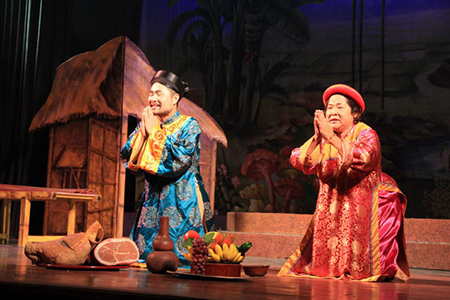Stereotyping the characters in cheo is conventional and standardized. Unlike the characters in spoken drama their personalities and psychology don't change during the play. They are drunken men deaf teachers wealthy men prime ministers students flirtatious women and buffoons. Cheo's minor characters are so interchangeable among the plays that most of these parts have no names. However over time some of these characters - such as Thi Kinh, Thi Mau and Thiet The - escaped from convention and anonymity to become strong personalities.
Buffoons play an important role in cheo plays because satire is a characteristic of the genre. as it is on the traditional stages of other Southeast Asian countries. Buffoons amuse audiences especially in sad stories. According to Shakespearean tradition life is a mixture of happiness and sadness. In clieo buffoons and funny scenes are an opportunity for ordinary people to lash out at the vices of a feudal society its kings, mandarin’s village officials and the rich. Cheo's buffoons were free to ridicule just as the fools did in the royal palaces of European kings. For example Chu Mai Than has a hilarious scene in which the first wife of local official Tuan Ty gets into a jealous quarrel with the second wife.

There are two types of satiric characters in cheo. The main one is the buffoon including he moi (buffoon dancing without a stick) and he gay (buffoon dancing with a stick) who is often a servant. The second type may appear in various roles such as fortune-teller, medium, drunkard or village chief. Sometimes these characters provoke laughter that is not directly related to the play since the buffoon (or the fortune-teller or drunkard. etc.) may comment on characters and incidents in society at large.
Satire in cheo is always linked to romance another significant feature. Cheo is romantic because it expresses people's individual emotions and feelings and reflects the common concerns of all people: their concern for love (as expressed by the characters Thi Mau and Chau Long) for friendship (represented by Luu Binh and Duong Le) and for compassion (as found in Thi Kinh the Goddess of Mercy). Characters especially women struggle with fate making cheo similar in some ways to Greek tragedy except for the hum our and happy ending.



